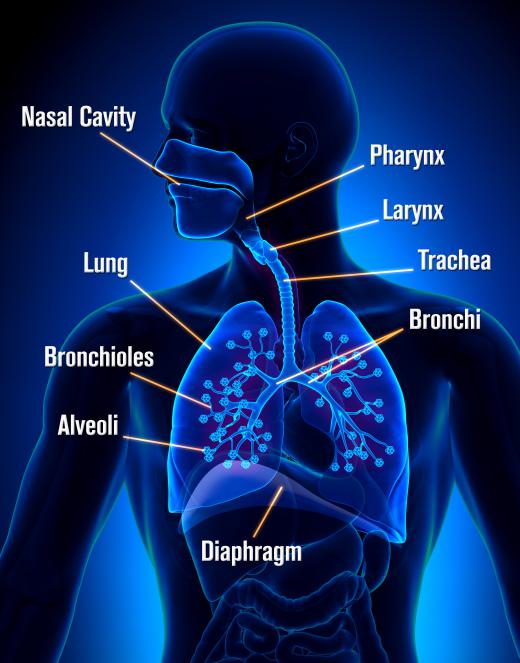What is Anaerobic Bacteria?
Anaerobic bacteria, or anaerobes, are bacteria that do not need oxygen to live. In humans, these bacteria generally live in the gastrointestinal tract, but they may also be found in other places outside the body, including in the soil and water, in foods, and in animals. Some anaerobes are beneficial to humans, but others can cause illnesses, such as appendicitis, diverticulitis, and gingivitis. Characteristics of an anaerobic bacterial infection are bad-smelling pus, the formation of abscesses, and the destruction of tissue.
Beneficial or Harmful

The Bacteroides genus is an example of anaerobic bacteria that is both beneficial and harmful. In the gastrointestinal tract, species from this genus aid digestion, but when in other areas of the body, they can cause sinus thrombosis, pneumonia, and meningitis, among other illnesses. Other anaerobes help people without living in their bodies. For example, some species of Lactobacillus are commonly used in cheese making. Likewise, some types of Clostridium can be used in bioremediation, which is the process of making contaminated soil usable again; they do this by attacking contaminates and converting them into nontoxic carbon dioxide.
Types of Anaerobes

There are three categories of anaerobic bacteria: obligate, aerotolerant, and facultative. Obligate anaerobes need an oxygen-free environment to live. They cannot grow in places with oxygen, which can sometimes damage and destroy them. Aerotolerant bacteria do not use oxygen to live, but can exist in its presence. Facultative anaerobes use fermentation to grow in places without oxygen, but use aerobic respiration in places with oxygen.

Porphyromonas gingivalis is an example of an obligate anaerobe. It's commonly found in the mouth, but is also thought to be connected with rheumatoid arthritis. A common example of an aerotolerant anaerobic bacteria is Propionibacterium acnes. It normally exists on people's skin, and is a contributing factor to acne. In some cases, it enters the body and causes endocarditis, which is an inflammation of the heart lining.

Some species in the Staphylococcus genus are facultative, and are a leading cause of blood poisoning. One example is Staphylococcus aureus, which produces a range of infections from common skin problems like acne, boils, and impetigo to acute conditions like meningitis, endocarditis, and pneumonia. It also causes toxic shock syndrome (TSS). Another facultative anaerobe is Escherichia coli, which contains many helpful strains of bacteria as well as some damaging ones, such as those that cause food poisoning.
Anaerobic Infections

Many anaerobes infect open wounds, diabetic skin ulcers, bites, and other skin lesions. Bacteroides are some of the most common anaerobic bacteria species in the foot wounds of diabetics. Often, anaerobes co-exist with aerobic bacteria, which need oxygen to thrive. This is common in foot ulcers, which makes them more difficult to treat.
Other anaerobes, such as those in the Actinomyces genus, can cause dental infections within the mouth. Mouth injuries, surgeries, or diseases can allow normally benign anaerobic bacteria to develop into infections, causing abscesses, pain, and inflammation. Rinsing with hydrogen peroxide releases oxygen, which can help destroy bacteria or slow its growth. Anaerobic mouth infections can also occur in the root canals, jaw, tonsils, and throat.

Sometimes anaerobes infect the lungs, causing abscesses, pneumonia, purulent pleurisy, and dilated lung bronchi. Other times they affect the abdomen, causing peritonitis and abscesses. Several species can be found throughout the body; for example, species in the Actinomyces genus generally appear in the oral cavity and upper respiratory tract, but may exist in the gastrointestinal tract. Other species live in specific areas, such as the colon. Bacteroides species are typically found in human feces, and cause tissue destruction when introduced into a wound.
Symptoms of Infection

The symptoms of an anaerobic infection typically vary according to its location, although pain and fever are quite common. For example, infections in the tooth and gum area often cause pain, swelling, and bleeding of the gums, as well as bad breath. In severe cases, a person may have oozing sores or large holes in the gums.
A person with a throat infection may have a sore throat, choking sensation, or fever, along with bad breath. People with lung infections may have difficulty breathing, as well as a cough, chest pain, and fever. Those with abdominal infections may experience fever and pain. If a person recently underwent surgery, there may be foul-smelling drainage from his or her wound. Pelvic infections generally cause pain, fever, chills, and drainage from the uterus.
Anaerobic bacterial infections in skin wounds generally appear as red, swollen areas, and they may secrete foul-smelling pus. Bloodstream infections often cause chills and high fevers, and can ultimately result in death. People with blood poisoning usually have red streaks in the skin near the wound, even if the wound does not appear to be infected.
Risk Factors
There is an increased risk of infection in those who have compromised immune systems, undergone surgery, or suffered an injury. People with diabetes mellitus, blood vessel disease, cancer, and tumors are also more prone to bacterial infections.
It is sometimes hard to know where a person contracted a bacteria-based illness. For example, bacteria spores in the Clostridium genus, which can cause tetanus, botulism, and gas gangrene, can live for a long time in harsh conditions before they germinate and grow. Many cases of infection are caused by several types of anaerobic bacteria working together.
Common Shapes
Anaerobes have many shapes. Actinomyces have rod shapes that may be straight, slightly curved, or branched. Propionibacterium also come in several shapes, such as oval, club-shaped, or rod-shaped, as well as branched and forked. Doctors and researchers use shape as one of the identifying factors when diagnosing a patient or studying a bacterium.
AS FEATURED ON:
AS FEATURED ON:

















Discussion Comments
Can porphyromonas gingivalis survive in aerobic conditions? If it can, how long can it survive in aerobic conditions?
Does Anaerobic bacteria affect periods? --Miss32
How can I avoid anaerobic bacteria? It sounds like they're everywhere, and can enter the body really easily.
Why doesn't the body just kill them off?
Some of the most well known anaerobic bacteria are called facultative anaerobic bacteria.
This includes the Staphylococcus bacteria, which causes the popularly called "staph" infection, e. coli, and listeria, which can cause everything from muscle-aches to convulsions.
Scary stuff, right?
Anaerobic bacteria can also be introduced into the body in the form of spores, which often occurs via a puncture wound.
Organisms known as "spore-producing anaerobes" live both in the ground and in water, and can cause serious infection if their spores enter the body.
Anaerobic bacteria are the most common cause of bad breath. The anaerobic oral bacteria often secrets an unpleasant odor that is worsened and further cultured by the dark wetness of the mouth. The compounds hydrogen sulfide, methyl mercaptan, cadaverine, putrescine, and skatole are the smelly waste products of anaerobic bacteria that cause bad breath.
Post your comments